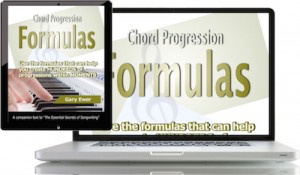One of the best ways to come up with creative chord progressions is to:
- make a very simple one as a first step, and then…
- modify certain chords within that progression.
That way, you start with something that works well, and then the slight modifications you make have the potential of creating entirely new moods. That’s often far better than throwing together unrelated chords until you find something you like.
 “Chord Progression Formulas” is an eBook that shows you how you can make dozens of progressions within moments, using very simple formulas. It’s a must for songwriters who focus on chords as a first step in the songwriting process. Get it separately, or as part of “The Essential Secrets of Songwriting 10-eBook Bundle”
“Chord Progression Formulas” is an eBook that shows you how you can make dozens of progressions within moments, using very simple formulas. It’s a must for songwriters who focus on chords as a first step in the songwriting process. Get it separately, or as part of “The Essential Secrets of Songwriting 10-eBook Bundle”
One of the best ways to create new moods within a progression is to use the minor iv-chord within a major key progression, what’s called a modal mixture. Here’s a simple version of what this means. (In Roman numerals, we show the normal major IV-chord as an upper case IV, and minor as lower case iv:
- Take a simple progression like this one: C F G C (I IV V I).
- Replace the F chord with Fm, giving you this: C Fm G C (I iv V I).
As you can hear, the Fm pulls the progression in a slightly darker direction. And it has the advantage of not throwing everything out; you retain the strength of the original progression.
That minor iv-chord is a real gem in pop songwriting. And in making the decision to use that chord, there are other ways to consider modifying it or at least changing the way it’s used, and so it becomes a very powerful option.
Here are some ways you can consider using the minor iv-chord in your progressions:
- Following a major IV. You can take the sample progression above, and then simply insert a quick minor iv after the major IV. This is quite likely the most common way to use the minor iv modal mixture. Listen:
- Adding a minor 7th to the top of the minor iv. A great new song, “Skin and Bones“, by Dutch indie band MILO, features this attractive chord in the bridge section. The song is in G major, and the bridge progression begins this way: Am G/B Cm7 Cdim7… (ii I6 iv-7 iv-dim…) The iv-7 is a beautiful choice, and it slides effortlessly into a diminished chord based on the 4th degree of the G major scale. Really nice!
- Following an inverted I-chord. To invert a I-chord means to put a note other than the root in the bass. Often, that note is the 3rd of the chord. So let’s say you have this as your progression:
C C/E F G C. That means that you play a C, then follow it with another C chord but with an E note as the lowest sounding pitch. Then on to the F, then G, and finishing with a C. It’s nice because it creates this pleasantly rising bass line. Now, change that F to Fm, and you get the top of the chord sounding like it’s pulling downward toward minor while the bass line is moving upward — a nice contrast. Listen:
- Changing key to minor i. It’s not all that common — but that might be a good reason for using it. Thinking in the key of C major, we know that a minor iv-chord comes from the key of C minor, and that’s why it’s called a modal mixture. So instead of throwing in a minor iv but staying in major (which is what all of our samples have done so far), why not take the opportunity to make a temporary change to the key of C minor? You’d get a progression that looks like this: C Fm Eb G/B Cm (I iv bIII V/6-4 i). From there, you can decide to move back to C major, or use it as the start of a brand new section of your song, this time in minor. Listen:
- Changing key to bIII. Another great way to temporarily change the tonal focus from I to and different key area — in this case, flat-III. The minor-iv gets reinterpreted as a ii-chord in bIII, and a typical progression might look like this: C Am Ab Fm |Eb (I vi bVI iv |bIII). Listen:
Requested file could not be found (error code 404). Verify the file URL specified in the shortcode.
One of the best reasons to use modal mixture chords like the minor iv is that it can be used in place of a chord that’s already there. That way, if your original simple progression works, you’ve got a good chance that the modal mixture will work nicely as well.
 Written by Gary Ewer. Follow Gary on Twitter.
Written by Gary Ewer. Follow Gary on Twitter.
 “The Essential Secrets of Songwriting” eBook bundle includes“Writing a Song From a Chord Progression”. Discover the secrets of making the chords-first songwriting process work for you.
“The Essential Secrets of Songwriting” eBook bundle includes“Writing a Song From a Chord Progression”. Discover the secrets of making the chords-first songwriting process work for you.










